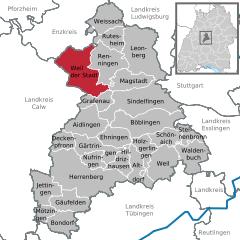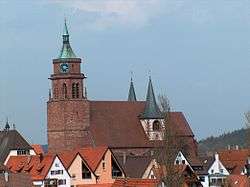Weil der Stadt
| Weil der Stadt | ||
|---|---|---|
|
Church of Saints Peter and Paul | ||
| ||
 Weil der Stadt | ||
Location of Weil der Stadt within Böblingen district 
 | ||
| Coordinates: 48°45′3″N 8°52′14″E / 48.75083°N 8.87056°ECoordinates: 48°45′3″N 8°52′14″E / 48.75083°N 8.87056°E | ||
| Country | Germany | |
| State | Baden-Württemberg | |
| Admin. region | Stuttgart | |
| District | Böblingen | |
| Government | ||
| • Mayor | Thilo Schreiber | |
| Area | ||
| • Total | 43.17 km2 (16.67 sq mi) | |
| Elevation | 406 m (1,332 ft) | |
| Population (2015-12-31)[1] | ||
| • Total | 18,652 | |
| • Density | 430/km2 (1,100/sq mi) | |
| Time zone | CET/CEST (UTC+1/+2) | |
| Postal codes | 71255–71263 | |
| Dialling codes | 07033 | |
| Vehicle registration | BB | |
| Website | www.weil-der-stadt.de | |
Weil der Stadt is a small town of about 19,000 inhabitants, located in the Stuttgart Region of the German state of Baden-Württemberg. It is about 30 km (19 mi) west of Stuttgart city center, and is often called "Gate to the Black Forest". The town is located in the beautiful valley of the river Würm.
Etymology
The original settlement was named Vila, from the Latin villa, which meant "estate, manor" and in late antiquity came to mean "small town". This evolved into Weil. Later the suffix "die Stadt" (the town) was added to distinguish the town from villages of the same name, such as Weil im Dorf and Weil im Schönbuch. The current name is unusual in that it contains the German dative case (the word Stadt is feminine). It arose because the place of issue in official documents was usually given as "gegeben zu Weil, der Stadt" ("issued in Weil, the town"). The Roman origins of the city are immortalized in the coat-of-arms which feature the SPQR motto ("Senatus Populusque Romanus", i. e. Senate and People of Rome).
History
| Imperial City of Weil der Stadt | ||||||||||
| Reichstadt Weil (der Stadt) | ||||||||||
| Free Imperial City of the Holy Roman Empire | ||||||||||
| ||||||||||
| Capital | Weil der Stadt | |||||||||
| Government | Republic | |||||||||
| Historical era | Middle Ages | |||||||||
| • | Founded | ca. sixth century | ||||||||
| • | Gained Reichsfreiheit | before 1275 | ||||||||
| • | Gained permanent seat in the Imperial Diet | 1489 | ||||||||
| • | Mediatised to Electorate of Württemberg | 1803 | ||||||||
| ||||||||||
In 1075 A.D., the village "Wile" was first mentioned in a document as the property of the famous monastery Hirsau. Weil der Stadt became a Free Imperial City in the 13th century, but had existed for centuries before as an important trading place.
It was completely destroyed during the Thirty Years' War in 1648 but was subsequently rebuilt, and the center is still dominated by buildings from this period. The city fortifications are still nearly intact with city walls, gates, and several towers called "Red Tower" or "Thief's Tower", "Rope-Maker's Tower", and "Raven's Tower".
Weil der Stadt is best known as the birthplace of both the astronomer Johannes Kepler (1571–1630) and the Protestant reformer Johannes Brenz (1499–1570) of Württemberg. The association with Kepler is the reason for the town's unofficial title ('The Kepler Town Weil der Stadt'). Due to its surroundings and attractive cityscape which is dominated by the church steeple of St. Peter and Paul, Weil der Stadt is a popular destination for excursions in the Stuttgart region.
At the beginning of the 19th century, Weil der Stadt became part of the Kingdom of Württemberg. Since 1952, the town has been part of the German Federal State of Baden-Württemberg.
Since 1973, Weil der Stadt has been part of the district of Böblingen, including the municipalities of Merklingen (not the same as Merklingen in Alb-Donau district), Hausen an der Würm, Schafhausen and Münklingen.
Weil der Stadt is connected to Stuttgart and Calw by federal highway B 295. Weil der Stadt station is on the Black Forest Railway (Württemberg) and is the terminus of line S 6 of the Stuttgart S-Bahn.
Events
Weil der Stadt is a stronghold of traditional carnival which is celebrated with a parade in the city center. In contrast to the carnival in the Rhineland, the carnival in Weil der Stadt, called Fasnet, is based on Alemannic (Germanic tribe) traditions which are celebrated in various towns in South Western Germany and Switzerland.
Weil der Stadt escaped destruction in World War II when a French artillery barrage was called off in honor of its being Kepler's birthplace.
References
Borst, Otto and Joachim Feist. Weil der Stadt. Stuttgart: Theiss Verlag, Second Edition 1989.
External links
- Official website (in German)
| Wikimedia Commons has media related to Weil der Stadt. |
- Marktplatz, Weil der Stadt, Baden Württemberg, Deutschland (360TOURIST Germany)




